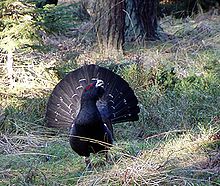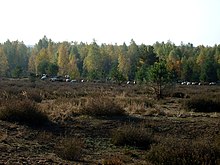Forsthaus Prösa nature reserve

The nature reserve “Forsthaus Prösa” is located about three kilometers north of Elsterwerda in the middle of the former Liebenwerdaer Amtsheide in the southern Brandenburg district of Elbe-Elster . One of the largest contiguous sessile oak forests in Central Europe extends here . The area, which was a restricted military area for decades as a military training area, is considered the core of the Niederlausitzer Heidelandschaft nature park , which covers an area of 484 square kilometers. With an area of 3,695 hectares, it is the largest nature reserve in the nature park.
Protection purpose
The protection purpose of the nature reserve "Forsthaus Prösa" consists in the preservation and development of the large-scale and contiguous undisturbed forest areas, which have existed here since the Middle Ages, with their dry open land areas created by military use as military training areas and the bodies of water and wetlands that are also included in the protected area with their resident rare and endangered animal and plant species.
fauna
This nature reserve offers ideal breeding conditions for endangered species such as the black stork , the middle woodpecker , the stock dove and the former capercaillie , which was able to survive here until the 1980s. Ground- nesting birds such as the common pipit , gray bunting , wheatear , partridge , wagtail , quail and goat milkers have their breeding grounds in the open . There are also notable occurrences of the dormouse , which is classified as “low endangered” on the Red List of Endangered Animal and Plant Species published by the International Union for Conservation of Nature and Natural Resources (IUCN) and prefers the deciduous forests in the area as habitat.
Among the insects found here are numerous species of grasshoppers , such as the gravel bank grasshopper ( Chorthippus pullus ) and other drought-loving invertebrates . There are also stag beetles .
flora
Beside one of the largest contiguous sessile oak forests in Europe, extends in a nature reserve, have become the former military use as a training area, especially stocks of sand dry grass , silver grass meadows and heather obtained which, forming a distinct heath. This landscape is cared for and preserved by grazing with sheep.
Other emerging rare plant species are the dwarf-cudweed and representatives of the family of the sweet grasses counting genus of spring fescue . In the old forest locations , blueberries and lingonberries dominate the ground vegetation.
history
"Bad Liebenwerda military training area"
From 1960 large parts of the area of the old Liebenwerdaer Amtsheide were used as a military training area for the NVA . The first commandant of the TÜP was Karl Losse. Although the area, the area around which is relatively densely populated, was not exactly classified as ideal, the construction of training facilities began in the spring of 1960, as the larger, historically developed military training areas in the GDR were largely in the hands of the Russian occupying forces . The neighboring communities were hardly or not at all consulted. By 1973 the area had been developed into a training site . A first shooting range was set up between the Turmberg and the "Drei Eichen" point. The first user was the so-called Panzerschule Grossenhain , whose vehicles mostly reached the site via tank roads from there. In order to create space for more shooting ranges and military facilities, an area of around 10 hectares in the sessile oak forest was cut down. The creation of driveways and routes was usually associated with major interventions in nature. Large forest areas were closed to the population for security reasons and to protect against Western espionage. In addition, the nearby old lignite mine "Gotthold" was closed, where the water training for pioneer troops and reconnaissance should take place. Because of the geological characteristics of the pit, these plans were never implemented. Until 1990 about 3000 hectares of the area were in military use.
From the end of the 1970s, the training and basic facilities were modernized. Shortly before the political change in the GDR , a complex camp was to be built on the grounds of the military training area, which was to become the most modern of its kind in the GDR territory. Among other things, an office for three hundred people was planned. The development work was to be carried out mainly by a Seddiner pioneer regiment of about eight hundred people . A year later, however, this project was put on hold.
Creation of the nature reserve "Forsthaus Prösa"

The negotiations taking place in Helsinki in 1988 for peace-building measures between the states of NATO and those of the Warsaw Pact formed the trigger for the creation of a nature reserve "Forsthaus Prösa". One of the results of the negotiations was that troop strengths should be reduced and military training areas should be turned over to civilian use. A dismantling of the Bad Liebenwerda military training area was also planned.
In December 1989, at the suggestion of the East German theologian Hans-Peter Gensichen , thirty well-known nature conservationists wrote a letter to Hans Modrow and Helmut Kohl , then heads of government of the two German states. This included, among other things, a quote from the Marburg ecologist Hermann Remmert with the words: "Nature conservation should now also raise its claim to hopefully becoming unnecessary military training areas and reserve them as national parks." From the book "Nature conservation: a reading book, not." only for planners, politicians and the like Police officers, publicists and the like Lawyers. "
As a result of these efforts, it was finally possible that the Liebenwerda military training area should be converted and advertised as a landscape protection area. Lieutenant Colonel Sigfried Welke, commandant of the military training area, received the order to dismantle the military training area at the beginning of 1990, which should become a pilot project that is unique in Europe and serve as a template for the conversion of further military training areas.
A short time later, the Green Round Table of the then Bad Liebenwerda district dealt with the future of the areas and in May 1990 the Ministry of Environment of the GDR commissioned a landscape planning for the Niederlausitzer Heidelandschaft nature park, including the area.
After the Federal Nature Conservation Act came into force in the new federal states with German reunification, the district council meeting on October 4, 1990 decided to place the nature reserve "Forsthaus Prösa" under protection.
Since May 2008 the nature reserve has been part of the "National Natural Heritage".
Literature (selection)
- Mähnert, P., K. Anders, I. Brunk, U. Nocker, M. Pilarski, J. Mrzljak, C. Saure, J. Vorwald & G. Wiegleb: "The former military training area Bad Liebenwerda (forester's house Prösa)" in " Open Land Management " . Springer-Verlag, New York, Berlin, Heidelberg 2004, ISBN 978-3-540-22449-5 , pp. 243-260 .
- Jörg Cötting-Frosinski: Experience eagles, otters, orchids in nature in Brandenburg's nature parks. A guide to the 15 large protected areas in Brandenburg . L & H Verlag, 2006, ISBN 3-938608-03-X .
- Uwe Lewandowski: "The Liebenwerdaer Amtsheide" in "Home Calendar - For the country between Elbe and Elster. No. 53 " . Ed .: Arbeitsgemeinschaft für Heimatkunde e. V. Bad Liebenwerda. Gräser Verlag Großenhain OHG, Bad Liebenwerda 1998, ISBN 3-932913-01-9 , p. 178-190 .
- Moritz Detel: “Off to the Prösa-a heath walk” in “Home calendar for the old district of Bad Liebenwerda, the Mückenberger Ländchen, outskirts on Schraden and Uebigau-Falkenberg” . Ed .: Arbeitsgemeinschaft für Heimatkunde eV Bad Liebenwerda. No. 54 . Gräser Verlag Großenhain, Bad Liebenwerda 2007, ISBN 3-932913-00-0 , p. 254-259 .
References and footnotes
- Information about the nature reserve "Forsthaus Prösa" (online as PDF file; 12 kB)
- ↑ The Niederlausitzer Heidelandschaft nature park on the homepage of the Brandenburg State Environment Agency ( memento of the original from April 11, 2009 in the Internet Archive ) Info: The archive link was automatically inserted and not yet checked. Please check the original and archive link according to the instructions and then remove this notice.
- ↑ Klaus Dietrich: Legend and Truth - on the history of the former military training area Liebenwerda. In: Home calendar for the old district of Bad Liebenwerda, the Mückenberger Ländchen, outskirts on Schraden and Uebigau-Falkenberg . Ed .: Arbeitsgemeinschaft für Heimatkunde eV Bad Liebenwerda. Bad Liebenwerda 2002, ISBN 3-932913-22-1 , p. 109-116 .
- ^ The Liebenwerda military training area on the homepage of the Federal Archives
- ↑ Nature conservation instead of commission - four former NVA areas become national natural heritage (May 13, 2008)
- ↑ Petra Wießner: “The way to the Niederlausitzer Heidelandschaft nature park” in “Local calendar for the old district of Bad Liebenwerda, the Mückenberger Ländchen, outskirts on Schraden and Uebigau-Falkenberg” . Ed .: Arbeitsgemeinschaft für Heimatkunde eV Bad Liebenwerda. Bad Liebenwerda 1997, p. 172-180 .
- ^ NABU Foundation for National Natural Heritage
Web links
- Nature reserves in the Niederlausitzer Heidelandschaft nature park
- Map of the nature park (PDF file; 858 kB)
- Image of the former military training area
Coordinates: 51 ° 30 '52.3 " N , 13 ° 31' 6.6" E




